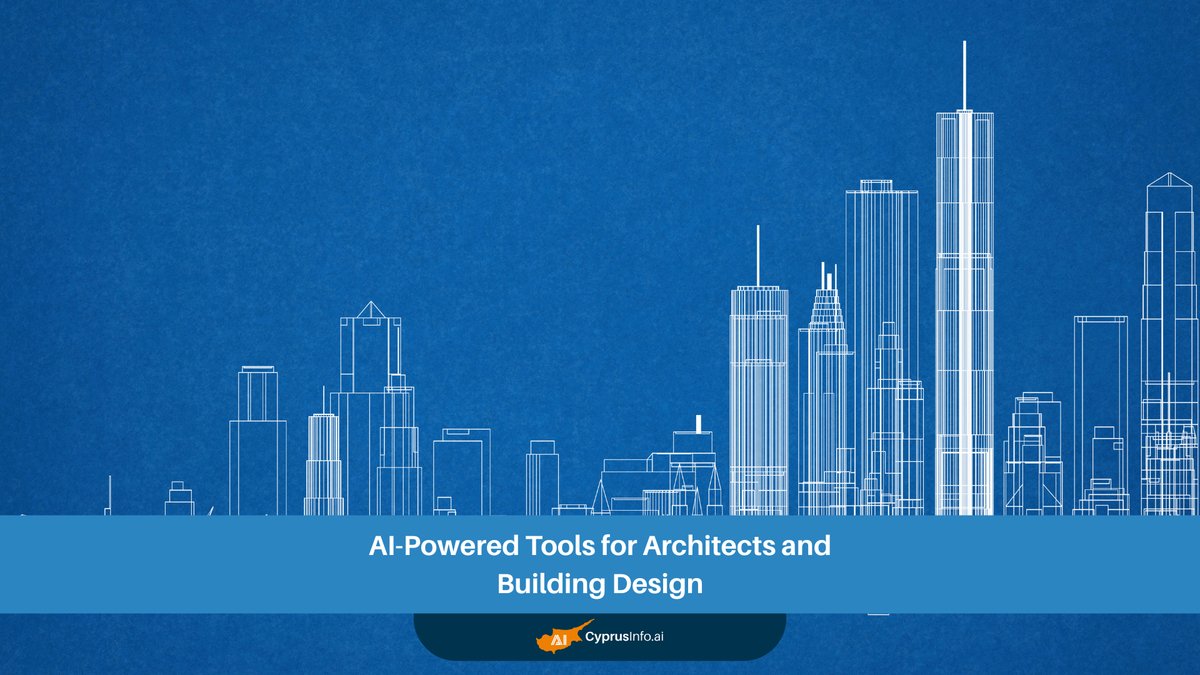The world of architecture and building design is undergoing a profound transformation, driven by the relentless advancement of artificial intelligence. What was once the exclusive domain of human creativity and meticulous manual drafting is now being augmented, accelerated, and optimized by AI in architecture. From concept generation to construction, AI-powered tools are reshaping how buildings are conceived, planned, and executed, promising unprecedented levels of efficiency, sustainability, and innovation. This comprehensive guide delves into the multifaceted applications of AI-powered tools for architects and building design, exploring their impact, benefits, and the exciting future they herald for the AEC (Architecture, Engineering, and Construction) industry.
AI in architecture isn't just a futuristic concept; it's a present-day reality empowering professionals to push boundaries and solve complex challenges. It offers solutions that enhance everything from aesthetic considerations to structural integrity and environmental performance. As we navigate this new era, understanding these tools becomes paramount for any architect or designer aiming to stay at the forefront of their field.
The Dawn of a New Era: Understanding AI in Architecture
The integration of artificial intelligence into architectural practice represents a paradigm shift. Historically, architects relied on intuition, experience, and often laborious processes. Now, AI systems can process vast amounts of data, identify patterns, and generate optimized solutions at speeds impossible for humans. This capability extends across the entire building lifecycle, making AI-powered tools for architects and building design indispensable.
The Essence of AI in Architecture
Efficiency Boost: Automates repetitive tasks, freeing architects for more creative problem-solving.
Data-Driven Decisions: Provides insights from complex datasets to inform design choices.
Generative Design: Creates multiple design variations based on specified parameters.
Predictive Analytics: Forecasts building performance, costs, and potential issues.
Sustainability Enhancement: Optimizes designs for energy efficiency and resource conservation.
As the industry embraces digital transformation, the role of architectural design software integrated with AI capabilities is expanding rapidly. This isn't about replacing the architect but augmenting their abilities, turning them into super-designers equipped with powerful analytical and generative tools.
Generative Design and Parametric Design AI: Unleashing Creativity
Perhaps one of the most exciting applications of AI in architecture is generative design. This technology allows architects to input design goals and constraints (e.g., maximum floor area, daylight requirements, structural limitations), and the AI then rapidly generates hundreds or thousands of design options that meet those criteria. This process is not about the AI designing for the architect, but rather exploring a far wider solution space than a human could ever manually achieve.
Quote: "The ultimate promise of AI in design is not to automate human creativity, but to amplify it, allowing us to explore possibilities we never could have imagined."
Complementing generative design is parametric design AI, which focuses on creating models where elements are defined by parameters and relationships. Changes to one parameter automatically update the entire design. When infused with AI, parametric tools can learn from successful designs and suggest optimal parameter values, further streamlining complex geometric and structural challenges. This fusion offers incredible flexibility and precision in the initial stages of a project.
Exploring the Capabilities of Generative Design Tools
Generative design tools leverage AI algorithms to iterate through design possibilities. Imagine designing a façade with optimal shading, views, and structural integrity; AI can evaluate countless permutations to find the best balance. This capability significantly reduces the time spent on initial conceptualization and optimization. Moreover, it allows for designs that are truly unique and performance-driven from the outset.
Generative Design vs. Traditional Design Process
Feature | Traditional Design Process | AI-Powered Generative Design |
|---|---|---|
Idea Generation | Manual, iterative, limited by human imagination | Automated, explores thousands of options, uncovers novel solutions |
Optimization | Manual adjustments, trial-and-error, time-consuming | Data-driven, rapid evaluation against multiple criteria |
Time to Concept | Weeks to months | Hours to days |
Complexity Handling | Challenging for multi-variable optimization | Excels at complex, multi-objective problems |
Innovation Potential | Limited by established patterns | High, due to exploring unconventional solutions |
This shift empowers architects to focus on strategic thinking and client engagement, while the AI handles the heavy lifting of exploring design permutations. It's truly a game-changer for the initial creative phase of building design.
AI and BIM Integration: The Smart Foundation for Building Design
Building Information Modeling (BIM) has already revolutionized the AEC industry by creating intelligent 3D models rich with data. The integration of BIM AI integration takes this a step further, infusing BIM models with artificial intelligence to unlock predictive capabilities and automation. AI can analyze BIM data to identify clashes, optimize material usage, predict construction timelines, and even automate the generation of detailed drawings based on preliminary designs.
This synergy creates a truly 'smart' foundation for projects. AI can learn from past projects stored in BIM libraries, suggesting more efficient design patterns or flagging potential issues before they become costly problems. For instance, AI could analyze a complex structural model within BIM to identify stress points and suggest reinforcement or alternative geometries, enhancing both safety and efficiency in building design.
Optimizing Construction with AI and BIM
Beyond design, AI integration with BIM significantly impacts the construction phase. AI can be used for AI construction defect detection by analyzing visual data from construction sites, ensuring adherence to design specifications and quality control. It can also aid in AI in construction procurement, optimizing material orders and supply chain logistics, minimizing waste and delays. The combination of these technologies represents a leap forward in project management and execution, ensuring that the vision created in architectural design software translates seamlessly into physical reality.
Sustainable Architecture AI: Designing for a Greener Future
With increasing global awareness of climate change, sustainable architecture AI is becoming an imperative, not just a preference. AI-powered tools are uniquely positioned to assist architects in designing environmentally responsible buildings. These tools can perform sophisticated simulations of energy performance, daylighting, natural ventilation, and material impacts far more rapidly and accurately than traditional methods.
AI can analyze local climate data, solar paths, wind patterns, and material properties to recommend optimal building orientations, facade designs, and HVAC systems that minimize energy consumption. It can even suggest innovative solutions for rainwater harvesting or waste management, turning abstract sustainability goals into quantifiable design decisions. This makes AI-powered tools for architects and building design crucial in the fight against climate change, enabling the creation of genuinely eco-friendly structures.
AI for Energy Efficiency and Environmental Impact
Using AI for energy management, architects can predict a building's energy usage throughout its lifecycle, allowing them to make informed choices during the design phase to reduce operational costs and carbon footprint. This extends to material selection, where AI can help designers choose materials with lower embodied energy and higher recyclability, contributing to a truly circular economy in construction. The precision offered by AI in predicting environmental impact allows for a holistic approach to sustainable building design.
Quote: "Sustainability is no longer an option; it's a design constraint that AI is helping us master with unprecedented detail."
Smart Building Design and Predictive Analytics in Architecture
The concept of a 'smart building' is intrinsically linked to AI. Smart building design integrates intelligent systems that can monitor and control various building functions, from lighting and temperature to security and maintenance. AI acts as the brain behind these systems, learning occupant preferences, predicting usage patterns, and optimizing building performance in real-time.
Predictive analytics architecture takes this a step further, using AI to forecast future conditions and outcomes. This could involve predicting potential structural weaknesses, equipment failures, or even shifts in occupant behavior. By anticipating these factors, architects and building managers can implement proactive solutions, improving safety, reducing operational costs, and extending the lifespan of the structure.
Leveraging Data for Better Buildings
The ability of AI in architecture to collect and analyze vast datasets, including IoT sensor data, historical performance records, and weather forecasts, transforms how buildings are designed and operated. For instance, AI can analyze foot traffic patterns within a building to optimize circulation paths or adjust lighting zones, leading to more comfortable and efficient spaces. This data-driven approach to architectural design software is revolutionizing the user experience within buildings.
Benefits of Smart Building Design & Predictive Analytics
Enhanced Occupant Comfort: Personalized environments based on learned preferences.
Operational Efficiency: Reduced energy consumption and maintenance costs through optimization.
Improved Safety & Security: AI-powered monitoring and anomaly detection.
Proactive Maintenance: Predicting equipment failure before it occurs.
Adaptive Environments: Buildings that respond intelligently to changing conditions.
AI-Driven Urban Planning and Infrastructure Design
The impact of AI in architecture extends beyond individual buildings to the broader urban fabric. AI-driven urban planning tools are emerging as powerful aids for city planners and developers. These tools can analyze complex urban data – including traffic flow, demographic shifts, environmental impact, and infrastructure stress – to model potential development scenarios and predict their outcomes.
For example, AI can simulate the effect of a new housing development on traffic congestion, public services, or green spaces, allowing planners to optimize designs for livability, efficiency, and sustainability. This capability helps create more resilient, equitable, and intelligent cities. Furthermore, AI can assist in AI for commercial site selection by analyzing factors like proximity to amenities, transport links, and demographic data to identify optimal locations for new developments.
Revolutionizing Infrastructure with AI
Beyond urban planning, AI is also transforming infrastructure design. From optimizing road networks to designing efficient public transport systems, AI can process vast amounts of data to create more resilient and responsive infrastructure. It can even assist in predicting the impact of natural disasters on infrastructure, informing more robust design choices. This holistic approach, powered by AI-powered tools for architects and building design, ensures that urban development is both smart and sustainable.
Automation in Architectural Design: Streamlining Workflows
One of the most immediate benefits of AI in architecture is the automation of routine and time-consuming tasks. This includes everything from generating preliminary layouts and drafting detailed drawings to quantity take-offs and compliance checks. By automating these processes, architects can significantly reduce project timelines and costs, allowing them to focus on high-value creative and strategic work.
Automated design processes, powered by AI, can quickly create various design options based on predefined rules and parameters. This is particularly useful for repetitive elements within a project, such as apartment layouts in a residential building or standardized components in a commercial complex. AI can also perform rapid code compliance checks, instantly flagging any design elements that violate local building regulations, thereby minimizing errors and rework.
Enhancing Efficiency with AI Workflow Automation
The integration of AI workflow automation into architectural firms is transforming operational efficiency. AI tools can manage project schedules, track progress, and even assist in resource allocation. This means architects spend less time on administrative tasks and more time on actual design and client interaction, leading to higher productivity and job satisfaction. The future of building design hinges on these smart efficiencies.
The Role of CyprusInfo.ai in Empowering Architects and Designers
At CyprusInfo.ai, we understand the evolving landscape of AI in architecture and are committed to empowering professionals in Cyprus and beyond with the tools and insights they need to thrive. While we don't directly develop architectural design software, our platform serves as a vital resource for businesses looking to leverage AI across various sectors, including the AEC industry.
CyprusInfo.ai offers:
Market Insights: Utilizing AI-driven analytics, we provide deep insights into construction trends, real estate markets (AI Cyprus real estate predicting property price trends), and investment hotspots, crucial for strategic architectural planning.
Business Intelligence: Our platform assists architects in identifying new business opportunities, understanding client needs through AI-powered market research (AI market research Cyprus), and optimizing their operational workflows.
Resource Aggregation: We curate information on the latest AI tools and technologies relevant to architectural and building design, helping professionals discover cutting-edge solutions.
Compliance and Due Diligence: For firms involved in large-scale projects, our AI-powered due diligence services (AI-powered due diligence Cyprus) can streamline legal and regulatory checks, crucial for mitigating risks in construction and property development.
Connecting Expertise: We facilitate connections within the professional community, helping architects find partners, investors, or specialized consultants who can enhance their AI integration strategies.
By leveraging the comprehensive intelligence offered by CyprusInfo.ai, architects and building designers can make more informed decisions, adopt innovative practices, and position themselves at the forefront of the AI revolution in their field. We provide the intelligence layer that complements the specialized AI-powered tools for architects and building design, ensuring a holistic approach to modernization and growth.
Challenges and Future Outlook of AI in Architecture
While the benefits of AI in architecture are immense, its adoption isn't without challenges. Concerns about data privacy, the need for robust computational infrastructure, and the continuous upskilling of the workforce are pertinent. Ethical considerations surrounding algorithmic bias in design outcomes, particularly in urban planning, also require careful attention.
However, the future outlook for AI-powered tools for architects and building design is overwhelmingly positive. We can anticipate even more sophisticated generative design algorithms, real-time feedback systems during design, and deeper integration of AI into every phase of a project. The continued development of virtual and augmented reality, combined with AI, will create immersive design and client presentation experiences. Ultimately, AI will foster a more collaborative and efficient design ecosystem, allowing architects to focus on the human element of design while leveraging machines for optimal performance.
Quote: "The architect of the future will be a conductor, orchestrating AI-powered tools to compose masterpieces of functionality and beauty."
Emerging Trends in Architectural AI Tools
Advanced Robotics Integration: AI controlling construction robots for complex tasks.
Digital Twins: AI-powered real-time simulations of buildings for ongoing optimization.
Natural Language Processing: AI understanding spoken or written design instructions.
Hyper-Personalization: Designs tailored to individual occupants' psychological and physiological needs.
The evolution of AI in architecture will not just change how buildings are made, but also how we live, work, and interact with our built environment.
Top Ten Frequently Asked Questions about AI in Architecture and Building Design
How does AI primarily benefit architectural design?
AI primarily benefits architectural design by automating repetitive tasks, generating numerous design alternatives, optimizing complex parameters for performance (e.g., energy efficiency), and providing data-driven insights that inform better decision-making.
Is AI replacing architects?
No, AI is not replacing architects. Instead, it serves as a powerful augmentation tool, enabling architects to work more efficiently, explore complex designs, and focus their creativity on higher-level problem-solving and client engagement.
What is generative design in the context of AI in architecture?
Generative design is an AI process where architects input goals and constraints, and the AI algorithm then rapidly generates a vast number of design options that meet those criteria, allowing for exploration of a wider solution space.
How does AI contribute to sustainable building design?
AI contributes to sustainable building design by simulating energy performance, daylighting, and ventilation; optimizing material selection for lower environmental impact; and suggesting optimal building orientations and systems to minimize resource consumption.
What is the role of BIM AI integration?
BIM AI integration enhances BIM models with AI capabilities to automate clash detection, optimize material usage, predict construction timelines, and generate intelligent insights from building data, making the design and construction process more efficient.
Can AI help with urban planning?
Yes, AI-driven urban planning tools analyze complex urban data (traffic, demographics, environmental impact) to model development scenarios, predict outcomes, and optimize designs for livability, efficiency, and sustainability in city development.
What are some common AI-powered tools for architects?
Common AI-powered tools for architects and building design include generative design software (e.g., Autodesk FormIt, Rhino.Inside.Revit with AI plugins), AI-driven simulation and analysis tools (for energy, acoustics), and AI modules integrated into BIM software.
How does predictive analytics apply to architecture?
Predictive analytics in architecture uses AI to forecast future conditions and outcomes, such as potential structural issues, equipment failures, or occupant behavior, allowing for proactive design adjustments and building management strategies.
Are there ethical considerations for AI in architecture?
Yes, ethical considerations include addressing potential algorithmic bias in design outcomes, ensuring data privacy and security, and the equitable distribution of AI benefits across different communities in urban planning.
How can I get started with using AI in my architectural practice?
To get started, begin by exploring existing architectural design software with AI features, investing in training for your team, experimenting with open-source AI tools, and consulting with experts or platforms like CyprusInfo.ai for market insights and resource aggregation.
Conclusion: The Future is Designed with AI in Architecture
The integration of AI in architecture marks a pivotal moment, ushering in an era where creativity is amplified by computational power. From the initial spark of generative design to the meticulous precision of BIM AI integration and the environmental foresight of sustainable architecture AI, these tools are redefining the capabilities of architects and designers. They promise not just greater efficiency but also the ability to tackle complex challenges with unprecedented insight, leading to more resilient, intelligent, and beautiful built environments.
Embracing AI-powered tools for architects and building design is no longer an option but a strategic imperative. As technology continues to evolve, the collaborative synergy between human ingenuity and artificial intelligence will undoubtedly shape the skylines and urban landscapes of tomorrow, crafting spaces that are not only aesthetically pleasing but also profoundly functional and sustainably sound. The future of design is smart, and it's powered by AI.



